
Cette série de earthcaches vous mènera sur un haut lieu de mémoire de Saint-Quentin. Outre le monument principal, plusieurs petits monuments, réalisés en diverses roches, se trouvent sur le site.
Le granite
Le granite est une roche magmatique, c’est-à-dire issue du refroidissement d’un magma formé lui-même par fusion partielle d’une roche en profondeur. Contrairement aux roches volcaniques (autre type de roche magmatique) dont le refroidissement est assez rapide lors d’une éruption volcanique, le granite est une roche plutonique, issue du refroidissement lent d’un magma en profondeur.
Ce refroidissement lent permet la cristallisation complète des minéraux (micas, feldspaths puis quartz). Une roche plutonique présente ainsi une structure grenue = formé uniquement de cristaux visibles à l’œil nu (phénocristaux).
Pluton granitique et métamorphisme de contact
Définition : le métamorphisme désigne l’ensemble des transformations subies par une roche (sédimentaire, magmatique ou métamorphique) sous l’effet de modifications de conditions de température, de pression, de la nature des fluides et, parfois, de la composition chimique de la roche. Ces transformations, qui peuvent être minéralogiques, texturales, chimiques ou encore structurales, amènent à une réorganisation des éléments dans la roche et à une recristallisation des minéraux à l’état solide.
La lente remontée d’un pluton granitique n’est pas sans conséquence sur la roche encaissante. Sous son action, celle-ci subit une augmentation de température à l’origine de transformations : on parle de métamorphisme de contact. Autour du granite se forme ainsi une auréole de métamorphisme, où les roches encaissantes sont transformées.
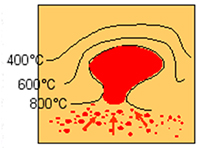
Intrusion d'un magma granitique métamorphisant et déformant les roches encaissantes
(métamorphisme de contact et déformation ductile)
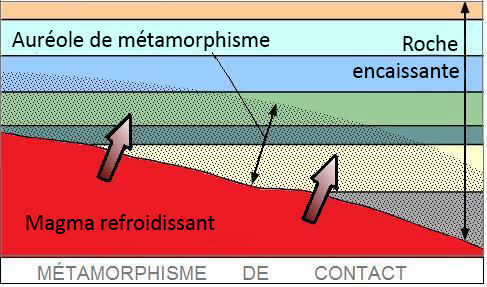
L’impact du pluton granitique décroissant en s’éloignant de celui-ci, on peut constater une succession de faciès métamorphiques du granite vers les roches encaissantes.
exemple :
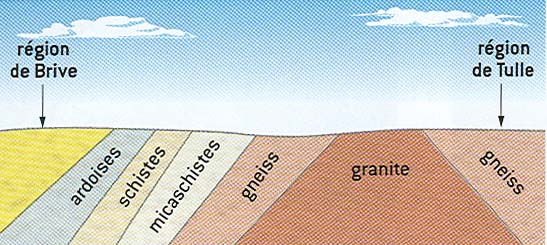
Le gneiss
Dans l’exemple ci-dessus, on peut observer des gneiss en contact direct avec le granite.
Gneiss est un vieux terme des mineurs allémaniques. Il s’agit d’une roche métamorphique présentant une alternance de lits clairs et foncés : les premiers sont constitués de cristaux blancs, gris ou rose de quartz et de feldspath de taille moyenne, tandis que les seconds, noirâtres, sont riches en éléments ferro-magnesiens (micas, amphiboles, hornblende). Suivant l’importance de la foliation, on distingue :
► Des gneiss rubanés, à lits bien marqués :

► Des gneiss granitoïdes à grains grossiers :
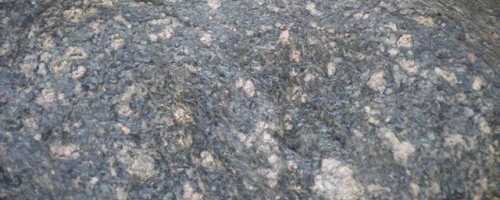
► Des gneiss oeillés à lentilles ovoïdes constituées de porphyroblastes de feldspath ou d’amas granoblastiques quartz-feldspath :

Outre les minéraux fondamentaux, les gneiss renferment fréquemment d’autres minéraux : grenat, sillimanite, cordiérite, disthène…
La structure en feuillets ou lits est généralement due à une déformation ductile qui s’est produite en même temps que le métamorphisme. Les plans ainsi définis sont appelés foliation et correspondent au plan d’aplatissement de la roche. Celle-ci a souvent été étirée en même temps qu’aplatie. On observe alors une linéation d’étirement, marquée par l’allongement des minéraux, sur les plans de foliation.
Xénolithes
Un xénolithe, ou xénolite, est une inclusion ou enclave étrangère dans une roche magmatique.
Une roche magmatique, qu’elle soit volcanique ou plutonique, se forme dans un réservoir magmatique dont les parois sont constituées de la roche encaissante. Lors du refroidissement et/ou de la remontée de ce magma, des fragments de roche encaissante peuvent se trouver arrachés et pris au piège dans le magma. Ils forment alors des xénolites une fois le magma refroidi.

Il est fréquent de retrouver des xénolites de péridotite (roche issue du manteau) dans un basalte (roche volcanique) ou de gabbro dans un granite.
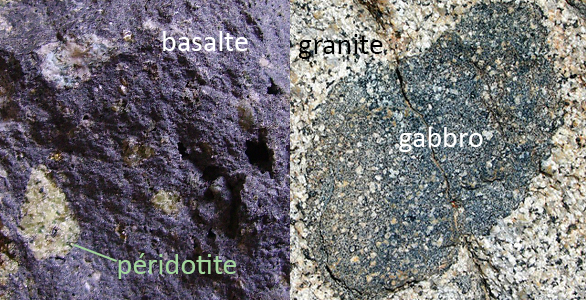
Dans l’exemple schématisé plus haut, la roche encaissante a été métamorphisée, devenant du gneiss à proximité immédiate du granite. Sur le monument principal du site, vous pourrez ainsi observer des xénolites de gneiss dans certains blocs de granite utilisés pour sa construction (ainsi que d’autres xénolites, de gabbro notamment).
La earthcache

Pour pouvoir valider cette earthcache, vous devrez répondre correctement aux questions suivantes.
Merci d’envoyer vos réponses via mon profil ou via la messagerie geocaching.com, ne les donnez pas dans votre log.
Vous pouvez ensuite loguer la cache "found it", je vous contacterai en cas de problème.
1) Qu'est-ce que le métamorphisme ?
2) Quel en est le responsable dans l'exemple étudié ici ?
3) Comment des morceaux de gneiss ont pu se retrouver piégés dans le granite ?
4) Sur la face avant du monument, retrouvez le xénolithe de la photo "Q4". Quels sont les deux noms inscrits à ce niveau ?
5) Descendez les escaliers situés sur la droite du monument. Un xénolithe assez grand se trouve à 2m50 de hauteur environ (voir photo "Q5"). Cette roche ayant subi des déformations, le xénolithe a une forme proche d'une lettre, laquelle ? (C, I, J, L, S, U, V ou W)
6) Vous pouvez également ajouter à votre log des photos d'autres xénolithes prises sur le monument, qu'il s'agisse de gneiss ou d'une autre roche (facultatif mais grandement apprécié).
Merci à yamathom pour la création de cette earthcache.

This series of earthcaches will take you on a place of remembrance of Saint-Quentin. Besides the main memorial, several smaller memorials, made of various rocks, are on the site.
Granite
Granite is a magmatic rock, that is to say, after the cooling of a magma itself formed by partial melting of a deep stone. Unlike volcanic rocks (another type of igneous rock) whose cooling is fast enough during a volcanic eruption, granite is a plutonic rock, resulting from the slow cooling magma at depth.
This slow cooling allows the complete crystallization of minerals (mica, feldspar and quartz). A plutonic rock has a granular structure = crystals visible to the naked eye (phenocrysts).
Granitic pluton and contact metamorphism
Definition: metamorphism means all the transformations undergone by a rock (sedimentary, igneous or metamorphic) under the effect of temperature and/or pressure condition, nature of the fluids and sometimes the chemical composition changes of the rock. These transformations, which can be mineralogical, textural, chemical or structural, lead to a reorganization of the elements in the rock and minerals to recrystallization in the solid state.
The slow rise of a granite pluton is not without consequences for the host rock. Under its action, it undergoes a temperature increase behind transformations is called contact metamorphism. Around the granite thus forms a halo of metamorphism, where host rocks are transformed.

intrusion of a granite magma that metamorphose and deform host rocks
(contact metamorphism and ductile deformation)

The impact of granitic pluton descending away from it, we see a succession of metamorphic facies from granite to the host rocks.
example:

Gneiss
In the example above, we can observe gneiss in direct contact with the granite.
Gneiss is an old Germanic minor term. This is a metamorphic rock with alternating light and dark layers: the first consists of white, gray or pink quartz and feldspar midsize crystals, while the latter, blackish, are rich in ferro-magnesian elements (mica, amphibole, hornblende). Depending on the degree of the foliation, can be distinguished:
► Banded gneisses, marked out layers:

► Granitoid gneiss, coarse grained:

► Eyed gneiss with ovoid lenses made of porphyroblasts feldspar or quartz-feldspar granoblastic clusters:

Besides the basic minerals, gneiss often contain other minerals: garnet, sillimanite, cordierite, kyanite...
The layered structure is usually due to ductile deformation that occurred along metamorphism. The thus defined planes are called foliation and correspond to the flattening plane of the rock. This has often been stretched simultaneously flattened. Then observed a stretching lineation, marked by the elongation of minerals, on the foliation planes.
Xenoliths
A Xenolith is a foreign inclusion or enclave in an igneous rock.
An igneous rock, whether volcanic or plutonic, formed in a magma chamber whose walls consist of the host rock. Upon cooling and / or the ascnet of this magma, fragments of the host rock can be torn off and trapped in the magma. Then they form xenoliths once the magma has cooled.
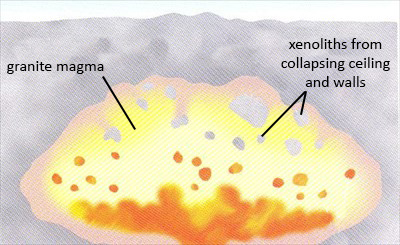
It is common to find peridotite xenoliths (rock from the mantle) in a basalt (volcanic rock) or gabbro in a granite.
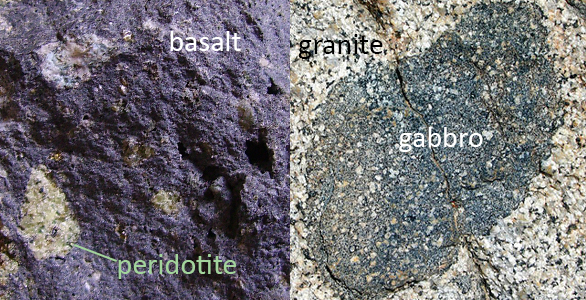
In the example shown schematically above, the host rock has been metamorphosed, becoming gneiss close to the granite. On the main memorial on the site, You can then observe gneiss xenoliths in some granite blocks used in its construction (and other xenoliths, including gabbro).
The earthcache

To be able to validate this earthcache, you will have to correctly answer the following questions.
Thank you for sending your answers via my profile or the geocaching.com messaging, don't take it in your log.
You can then post your log "found it", I shall contact you in case of problem.
1) What is metamorphism ?
2) What is the origin in the example studied here?
3) How pieces of gneiss could become trapped in the granite?
4) On the front of the memorial, find the xenolith of the picture "Q4". What are the two names inscribed at this level?
5) Go down the stairs located on the right of the monument. A relatively large xenolith is about 2.50m in height (see photo "Q5"). This rock has undergone deformation, the xenolith has a similar form to a letter, which one? (C, I, J, L, S, U, V or W)
6) You can also add to your log a picture of another xenolith taken on the memorial, whether gneiss or another rock (optional but strongly appreciated).
Merci à yamathom pour la création de cette earthcache.